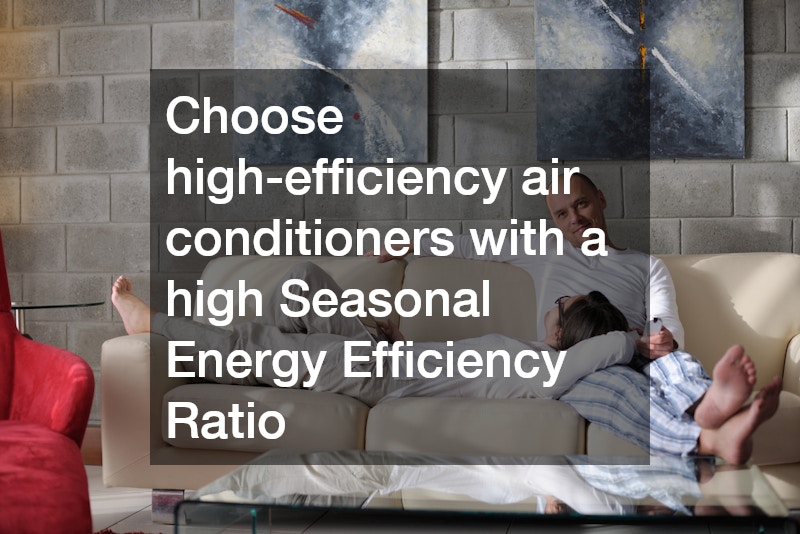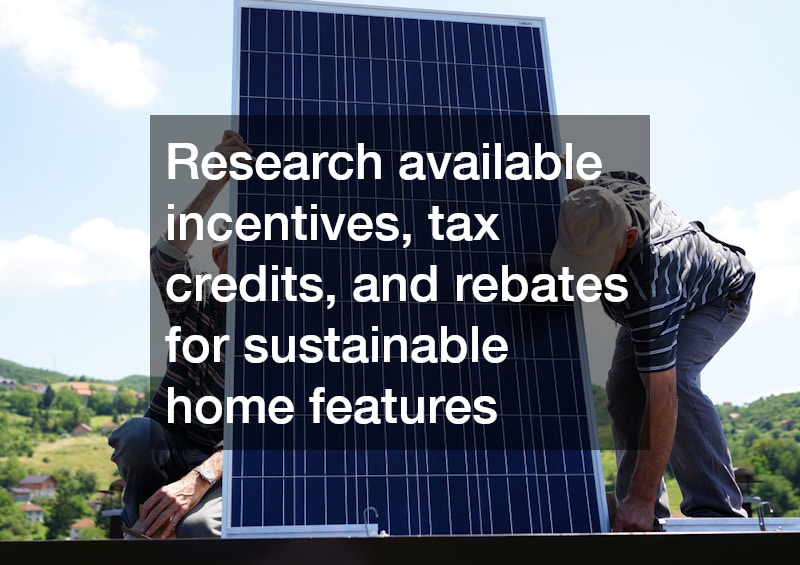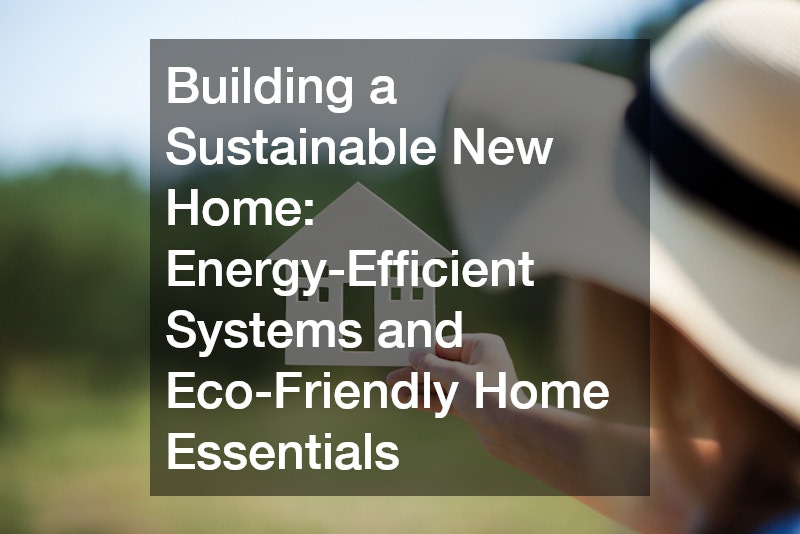Building a sustainable home is no longer just a trend; it’s a necessity. With rising energy costs, climate change concerns, and an increasing focus on green living, homeowners are prioritizing eco-friendly construction methods and energy-efficient systems. A sustainable home not only reduces environmental impact but also offers long-term savings on energy and maintenance costs. By carefully selecting materials, systems, and professionals, you can design a home that balances comfort, functionality, and environmental responsibility. This guide outlines the essential systems, features, and considerations for building a sustainable new home.
1. Designing an Eco-Friendly Home: Where to Begin
Building an eco-friendly home requires a comprehensive approach that considers not only the materials used but also the systems and design strategies implemented throughout the construction process. A sustainable home is built on thoughtful planning and expert guidance, ensuring every element works together to minimize environmental impact and maximize efficiency. By involving experienced professionals and making deliberate choices in materials and features, homeowners can create a residence that is both functional and environmentally responsible.
Partnering with an Experienced Builder
One of the first steps in designing a sustainable home is selecting the right builder. A knowledgeable home builder who specializes in sustainable construction can guide you through the process, from initial planning to final inspections. Their expertise ensures that your home incorporates the latest eco-friendly technologies and design principles.
- Finding the Right Builder: Look for builders with certifications in green construction, such as LEED (Leadership in Energy and Environmental Design) accreditation or other relevant credentials. Check for portfolios that highlight energy-efficient and eco-conscious projects, and read reviews from previous clients to assess their reliability and expertise.
- Sustainable Layouts: A skilled builder can design layouts that reduce energy consumption by optimizing natural light and ventilation. Features like large south-facing windows (in northern climates) or overhangs that block summer sun can reduce dependence on artificial lighting and HVAC systems.
- Collaborative Design Process: Partnering with your builder early in the process allows for a collaborative approach where architects, engineers, and contractors can work together to integrate sustainable features into every aspect of the design.
Using Sustainable Materials
The materials chosen for your home play a pivotal role in its environmental impact. Opting for sustainable options not only reduces the carbon footprint of construction but also ensures long-term durability and efficiency.
- Recycled and Renewable Materials: Consider using recycled steel for framing, which is both durable and reduces the need for newly mined resources. Reclaimed wood adds character to a home while cutting down on deforestation, and bamboo offers a rapidly renewable alternative for flooring or cabinetry.
- Eco-Friendly Insulation: Insulation is critical for maintaining comfortable indoor temperatures while minimizing energy usage. Materials like cellulose insulation, made from recycled paper, or spray foam insulation, which seals gaps effectively, can drastically reduce heat transfer and energy loss.
- Low-VOC Materials: Volatile organic compounds (VOCs) in paints, adhesives, and finishes can negatively impact indoor air quality. Choosing low-VOC or VOC-free options protects the health of your family while being better for the environment.
Optimizing Roofing Options
The roof is one of the most significant contributors to a home’s energy efficiency. Choosing the right roofing system can have a substantial impact on heating, cooling, and overall energy consumption.
- Cool Roofs: Cool roofs are designed with reflective materials that reduce heat absorption, keeping the home cooler in hot climates and reducing the need for air conditioning. Options include light-colored asphalt shingles, metal roofing, or tiles with reflective coatings.
- Green Roofs: A green roof, or living roof, incorporates vegetation planted over a waterproof membrane. This design provides excellent insulation, absorbs rainwater, and improves air quality. Green roofs also extend the life of the underlying roof structure by protecting it from UV rays and temperature extremes.
- Solar-Ready Roofing: If renewable energy is a goal, work with a roof contractor to install a solar-ready roofing system. This involves using materials and designs that accommodate solar panel installation, ensuring maximum efficiency and ease of integration when you decide to add solar power.
2. Sustainable HVAC Systems: Saving Energy Without Sacrificing Comfort
Heating, ventilation, and air conditioning systems are among the largest energy consumers in a home. Investing in modern, energy-efficient HVAC systems ensures your home remains comfortable while reducing energy usage. Sustainable HVAC solutions also improve indoor air quality, making your living space healthier for your family.

- Energy-Efficient Air Conditioning Systems
Choose high-efficiency air conditioners with a high Seasonal Energy Efficiency Ratio (SEER) rating. Work with experienced professionals for proper air conditioning installation, as poor installation can lead to energy loss and increased costs. Consider ductless systems for specific zones in your home to avoid energy waste. - Smart Thermostats and Zoning Systems
Install smart thermostats that learn your preferences and adjust temperatures automatically to save energy. Zoning systems allow you to heat or cool specific areas of your home, reducing energy consumption in unused spaces. Both features are invaluable for achieving a sustainable home. - Regular HVAC Maintenance
Partner with reliable heating and air services to maintain your systems regularly. Proper maintenance, such as cleaning filters and checking for leaks, ensures your HVAC systems operate at peak efficiency, prolonging their lifespan and saving you money.
3. Eco-Friendly Water Systems: Reducing Waste and Maximizing Resources
Water conservation is an integral part of sustainable home design. As global water resources face increasing strain, implementing eco-friendly water systems can make a significant difference in reducing waste and ensuring resource availability for future generations. Efficient water management also translates to lower utility bills, saving money while promoting environmental responsibility. By incorporating advanced systems and sustainable practices, you can design a home that uses water wisely without sacrificing comfort or convenience.
Efficient Plumbing and Fixtures
Modern plumbing technology offers numerous solutions for conserving water while maintaining excellent performance. Updating or installing efficient fixtures is one of the simplest ways to reduce water usage in your home.
- Low-Flow Faucets and Showerheads: These devices restrict water flow without affecting water pressure, saving thousands of gallons annually. Many models also come with aerators that mix air with water, enhancing the flow feel while using less water.
- Dual-Flush Toilets: These toilets allow users to select a low-flow option for liquid waste and a higher-flow option for solid waste, using only the necessary amount of water. Over time, this reduces water consumption significantly compared to traditional single-flush toilets.
- Leak Detection and Smart Systems: Integrate smart water monitors that detect leaks and provide real-time data on water usage. By identifying and fixing leaks early, you can prevent wastage and costly damage.
- Greywater Systems: Greywater recycling systems capture wastewater from sinks, showers, and washing machines, treating it for reuse in irrigation or toilet flushing. This reduces reliance on freshwater supplies while maximizing resource efficiency.
Rainwater Harvesting Systems
Rainwater harvesting is an effective method to collect and utilize free water from natural rainfall. This system not only helps reduce reliance on municipal water supplies but also promotes sustainable landscaping practices.
- How Rainwater Harvesting Works: Install gutters and downspouts to channel rainwater into storage tanks or underground cisterns. These tanks can be fitted with filters to ensure water quality for non-potable uses like irrigation, washing outdoor surfaces, or even flushing toilets.
- Irrigation Benefits: Rainwater is naturally soft and free of chemicals, making it ideal for watering gardens and lawns. By using harvested rainwater, you conserve potable water and reduce strain on local water resources.
- Scaling the System: Simple rain barrels are affordable and easy to install, suitable for smaller-scale uses. Larger systems with automated pumps and purification options can meet more extensive water needs, adding long-term value to your home.
An Eco-Conscious Septic System
Homes without access to municipal sewer systems require a septic system for wastewater treatment. Investing in eco-friendly septic tank installation ensures that waste is managed efficiently with minimal environmental impact.
- Modern Septic Systems: Advanced septic tank systems use biological processes and aeration to break down waste more efficiently than traditional models. They reduce the risk of harmful pollutants leaching into the soil or groundwater.
- Regular Maintenance: Work with experienced septic professionals to schedule routine inspections and maintenance. Regular pumping and cleaning keep the system functioning optimally, extending its lifespan and preventing costly failures.
- Environmental Benefits: Eco-conscious systems reduce greenhouse gas emissions and nutrient pollution, protecting local ecosystems. They are especially beneficial in sensitive areas near wetlands or water bodies.
Energy-Efficient Pool Features
If your home includes a swimming pool, it’s crucial to ensure that it operates efficiently to avoid excessive energy and water consumption. Modern pool service and technologies offer sustainable solutions that maintain enjoyment while lowering environmental impact.
- Variable-Speed Pumps: These pumps use less energy than traditional single-speed pumps by adjusting speed based on the pool’s needs. They are a simple upgrade that drastically reduces energy usage.
- Solar-Powered Heaters: Solar heaters use renewable energy to maintain comfortable water temperatures. They are an eco-friendly alternative to gas or electric heaters and have minimal operational costs after installation.
- Automated Pool Covers: A pool cover reduces water evaporation and heat loss, conserving water and energy. Automated systems make it convenient to use, ensuring your pool remains efficient year-round.
- LED Pool Lighting: Replace traditional incandescent pool lights with energy-efficient LED options. LEDs consume significantly less electricity and have a longer lifespan, reducing both energy costs and maintenance needs.
4. Landscaping and Outdoor Features for a Sustainable Property
Your home’s exterior is as important as its interior when it comes to sustainability. Eco-friendly landscaping and outdoor features not only enhance curb appeal but also contribute to a healthier environment. Proper planning and collaboration with professionals ensure a functional and beautiful outdoor space.

- Sustainable Driveway Materials
Partner with an asphalt driveway company to install a permeable or recycled asphalt driveway. These materials allow water to seep through, reducing runoff and preventing erosion, while recycled options minimize resource use. - Native and Drought-Resistant Plants
Design your landscaping with native and drought-resistant plants that require minimal water and maintenance. Native plants also support local ecosystems by providing habitat for pollinators and wildlife. - Energy-Efficient Pool Design
Work with swimming pool builders to incorporate sustainable features like solar pool heaters, automated covers, and LED lighting. These additions reduce energy and water usage while maintaining a luxurious outdoor experience. - Sustainable Outdoor Lighting
Use solar-powered outdoor lighting to illuminate your property without increasing energy consumption. These lights are easy to install, cost-effective, and environmentally friendly.
5. Customization and Sustainable Additions for Long-Term Value
Customization offers homeowners the unique opportunity to create a space tailored to their lifestyle, priorities, and future needs. Incorporating sustainable features during the customization process not only enhances the home’s functionality but also increases its value and reduces its environmental impact. Thoughtful, eco-friendly additions—ranging from energy-efficient garages to renewable energy systems—can future-proof your home while aligning with your commitment to sustainability.
Eco-Friendly Garage Design
The garage is more than a place to park vehicles; it can be transformed into a sustainable, multi-functional space. Working with a custom garage builder ensures that your garage meets both practical needs and environmental goals.
- Sustainable Materials: Choose eco-friendly materials like recycled steel for framing or reclaimed wood for finishes. These materials are durable and reduce the environmental footprint of construction.
- Energy-Efficient Features: Insulate the walls and doors of your garage to maintain a stable temperature, reducing the need for heating or cooling. Install energy-efficient LED lighting to minimize electricity use while ensuring adequate illumination.
- Natural Lighting and Ventilation: Incorporate windows or skylights to reduce dependence on artificial lighting. Proper ventilation systems can prevent heat buildup and improve air quality, especially in climates with extreme temperatures.
- EV Charging Stations: As electric vehicles (EVs) become increasingly popular, adding a charging station is a forward-thinking investment. Ensure the electrical system in your garage can support EV chargers, making your home future-ready.
- Multi-Use Garage Spaces: Customizing your garage to include storage for tools, workstations, or even gym equipment can make it a versatile part of your home. Adding sustainable shelving or cabinetry made from recycled materials further enhances its eco-friendly appeal.
Renewable Energy Solutions
Incorporating renewable energy systems during the design phase can significantly reduce your home’s dependency on non-renewable energy sources. These systems not only lower utility bills but also decrease your household’s carbon footprint.
- Solar Panels: Install rooftop solar panels to harness clean, renewable energy from the sun. Partner with professionals to evaluate your home’s orientation and roof design for maximum efficiency. Solar panels can power everything from appliances to HVAC systems, reducing your reliance on grid electricity.
- Battery Storage Systems: Pair your solar panels with battery storage to save excess energy for use during peak hours or power outages. This system increases your home’s energy self-sufficiency and ensures reliability.
- Wind Turbines: For homes in windy areas, small-scale wind turbines can be an effective source of renewable energy. These systems can supplement solar panels, especially during seasons with less sunlight.
- Solar Water Heaters: Replace traditional water heaters with solar-powered alternatives. These systems use the sun’s energy to heat water, offering a cost-effective and sustainable solution for daily needs.
Comprehensive Customization
Custom home builders play a vital role in integrating sustainable practices throughout your home’s design. Their expertise ensures every feature works cohesively to enhance energy efficiency, reduce waste, and improve overall comfort.

- Efficient Layouts: Design a home layout that maximizes natural light and ventilation. South-facing windows in colder climates can reduce heating needs, while strategically placed windows and overhangs in warmer regions can minimize cooling costs.
- Smart Home Technology: Incorporate smart home systems that monitor and optimize energy usage. Features like automated lighting, temperature control, and energy tracking allow homeowners to reduce consumption and costs.
- Water-Saving Features: Integrate greywater recycling systems, low-flow fixtures, and rainwater harvesting setups into your home’s design. These features ensure efficient water use without sacrificing convenience.
- Sustainable Finishes: Choose eco-friendly finishes such as low-VOC paints, bamboo flooring, or countertops made from recycled glass. These options reduce environmental impact while adding style to your home.
- Future-Proof Designs: Plan spaces that can evolve with your needs. For example, a garage with an EV charging station or a flexible room that can transition between a home office and guest suite ensures your home remains functional as your lifestyle changes.
6. Budgeting for Sustainability: Costs vs. Long-Term Savings
Building a sustainable home often requires higher upfront investments, but the long-term savings and benefits far outweigh the initial costs. Proper budgeting and an understanding of incentives can make eco-friendly features more accessible.
- Weighing Costs and Benefits
Evaluate the upfront costs of energy-efficient systems, like modern HVAC units and eco-friendly septic solutions, against their long-term savings on energy and water bills. Prioritize features that offer the best return on investment. - Taking Advantage of Incentives
Research available incentives, tax credits, and rebates for sustainable home features such as solar panels, high-efficiency HVAC systems, and water-saving technologies. These financial benefits can significantly offset initial costs. - Working with Specialists
Partner with experienced professionals like roof contractors, heating and air services, and asphalt driveway companies. Their expertise ensures quality installations that maximize efficiency and minimize future repair costs.
Your Sustainable Dream Home Awaits
Building a sustainable home is an investment in the future—both for your family and the environment. By incorporating energy-efficient systems, eco-friendly materials, and thoughtful design, you can create a home that is both functional and environmentally responsible. Collaborate with experienced professionals and take advantage of available resources to ensure your home meets your sustainability goals while offering long-term comfort and savings.
